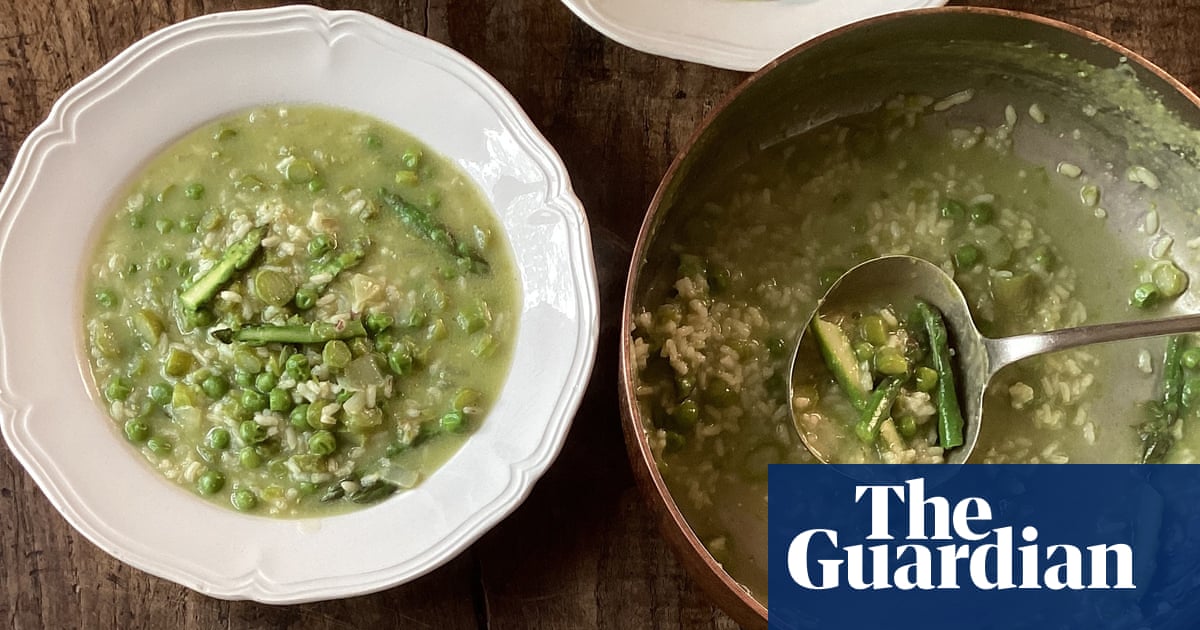According to theGuinness World Record’s official website, 351.7cm was the length of the asparagus presented by Harry and Carson Willemse at thePort Elgin Pumpkinfestin Ontario, Canada, on 2 October 2004. Sadly, however, the Pumpkinfest’s own archives hold only the records of master growers and weigh-offs dating back to 2017, and are almost entirely pumpkin-related. Gardening websites and Pinterest, however, offer more insight into how asparagus, left unpicked, quite quickly reaches 6ft and develops branches and soft, feathery foliage. I assume Harry and Carson must have pulled away the ferns in order for their spears to grow to 3½m, which is a metre more than the average UK ceiling and almost the same length as a Mini Cooper, and the equivalent of 16-20 average-length spears laid across the kitchen floor.
Those average-length spears, however, are as much a sign of spring as blossom and barometric pressure-change lethargy (my tortoise and I are diametrically opposed for about 10 days every spring: him coming out of hibernation, me wishing I could enter it). Despite myself, we have been enjoying asparagus: boiled and covered with melted butter; rolled in salt and pepper, roasted on the griddle, then dressed with bitter orange; and turned into soup.
If asparagus are medium-sized or slim, a good and quick way to get rid of the woody ends is to bend the spears until they snap at their natural breaking point. It is true, though, that this method can sacrifice a significant part of the spear, especially if the asparagus is more medium- to plump-sized, so another method is to use a potato peeler to pare away the fibrous outer layers that thicken the end of each spear – think of it as sharpening a pencil. Another way to get the most out of a bundle is to use the tough butts or peelings to make a light stock (boil them with a halved onion in a litre and a half of water for about 20 minutes, then strain).
If you don’t fancy this additional step, though, plain water is fine for today’s recipe, which is inspired by the Venetian way of cooking rice and peas (risi e bisi) and also incorporates a whole bunch of asparagus. The recipe also incorporates a friend’s tip of scooping out about a third of the soupy vegetables and rice for the last few minutes of cooking, blending it smooth (and milky-green), then returning it to the pan, where it thickens and brings everything together.
This is a dish that thickens as it cools, so get it to the table and serve as soon as possible, passing around some grated parmesan and olive oil for those who want to put them on top.
Serves4
1 large bunch asparagus (about 600g)30gbutter3-4 tbsp olive oil,plus extra to serve2 shallots, peeled and dicedSalt200g podded fresh peas, or frozen and defrosted peas200g rice, such as carnaroli, arborio or long-grain1½ litres warm stock made with the asparagus trimmings, or waterGrated parmesan, to serve
Break the tips off the asparagus and set aside, then snap off or use a peeler to pare away the tough ends of the remaining spears, and cut the trimmed stalks into 2-3mm rounds. If you wish, boil the ends or trimmings in a litre and a half of water to make a light stock – water is fine, too.
In a heavy-based pan, warm the butter and olive oil until the butter foams. Add the shallots and a pinch of salt, fry gently for a few minutes, then add the asparagus rounds and peas, and stir for a few minutes, so everything glistens. Add the rice and another pinch of salt, stir again, then add the water or stock. Leave it to come to a boil, then turn down to a simmer and cook, stirring occasionally, for 20 minutes.
Five minutes before the end of cooking, remove a third of the soup, blend this until smooth, then return it to the pan along with the asparagus tips (sliced in half if thick). By the end of the cooking, the consistency should be dense but still soupy, so add a little more water if required. Serve with grated parmesan and olive oil on the side for those who want some.
